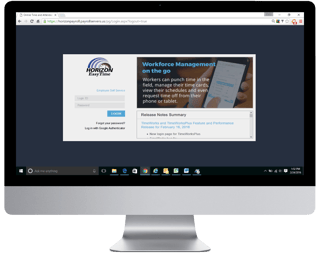2 min read
High Turnover Does Not Have To Mean High Cost
The restaurant industry is known for its high employee turnover rates. According to the National Restaurant Association, "the turnover rate in the...
Expert payroll management services with a personal touch.
View Solution Read Guide HR Support
HR SupportSimplify and personalize HR with a team of HR experts on-demand.
View Solution Read Guide Time & Attendance
Time & AttendanceWhy spend more unnecessary time and money managing your workforce?
View Solution Read Guide Hiring & Onboarding
Hiring & OnboardingTurn your candidates into employees with hiring & onboarding solutions.
View Solution Read GuideAdd On Solutions automate everyday tasks, prevent mistakes, and simplify business compliance.
View SolutionHelpful downloads and eBooks to empower your business.
Helpful tax and HR alerts to help keep your business compliant.
Payroll and tax-related forms and documents.
Horizon's blog provides valuable insight into payroll, compliance, human resources, and more.
See our client success stories for a case study on how we can help your business.
Payroll and HR strategy requires intelligent technology, personal attention and specialized expertise in the needs and nuances of your business.
We provide payroll and tax processing services for businesses from 1 to 1,000 employees or more. Today, we have nearly 1,000 customers in 40 states.
2 min read
Brad Johnson : June 8, 2016 at 4:51 PM
You've probably heard about the recent changes to the FLSA (Fair Labor Standards Act). As Forbes puts it, these changes will make millions more employees eligible for overtime while making compliance more challenging for business leaders. This new rule is just one reason you should be thinking about automated timekeeping and scheduling.
Another stark fact - studies have found that each time an employee is distracted during the workday (e.g., checks their Instagram feed), it takes them an average of 23 minutes to re-focus. Using today's average wages, that's $8.69 an employer is throwing away - per distraction. Multiply that by many distractions and you're wasting hundreds per week.
Enter timekeeping and scheduling. The right tools can help your employees stay motivated and productive, saving your business money, while maintaining the important relationship between an employer and employee. Let's examine three big ways these tools can help.

1. Know Your Coverage
To create and foster an efficient workplace, you must evaluate the demands of your business and line these demands up with your employee schedules and strengths. Scheduling technology helps you identify:
2. Project Your Labor Costs
Cost of labor is defined as the sum of all wages paid to employees, as well as the cost of employee benefits and payroll taxes paid by an employer. Labor costs can also be considered the costs of producing one unit of output. Managing the number of hours your employees work can increase the productivity of your everyday operations and create a lasting, efficient schedule.
A simple scheduling tool might seem to just shuffle around your employees. Sure, the schedules are efficient, but what about costs and revenue? Scheduling and timekeeping, when done right, can also tell the story of your business costs and revenue. How can you ensure a healthy business with the help of these tools?
3. Communicate Easily and Effectively
Finally, efficient scheduling should lead to easy communication between employer and employee. Gone are the days of Excel spreadsheets or Word docs sent by email. There are several ways a proper scheduling tool can build an efficient relationship between employer and employee:
Need help sorting through the tools? Wonder if you're actually losing money on manual timekeeping? Contact us today, or click below for your timekeeping worksheet.

2 min read
The restaurant industry is known for its high employee turnover rates. According to the National Restaurant Association, "the turnover rate in the...

2 min read
Think you don't need automated timekeeping? Think again. But what exactly is it and how can it help your business?

4 min read
Accurate timekeeping is undoubtedly one of the top ways to ensure your company’s financial health. Small errors, even those that affect several...